Synthesis and Diagnostics of Nanostructured Micaless Microcomposite as a Prospective Insulation Material for Rotating Machines
Abstract
1. Introduction
2. Materials
2.1. Matrix
2.2. Filler and Coupling Agent
2.3. Reinforcement
2.4. Synthesis of Nanostructured Micaless Microcomposite
2.5. X-ray Diffraction Analyses of Synthesized and Commonly Used Composites
3. Methods
3.1. Key Dielectric Parameters
3.2. Broadband Dielectric Spectroscopy
3.3. Resorption Current Analysis
3.4. Partial Discharges Measurement
4. Results and Discussion
4.1. Key Dielectric Parameters
4.2. Broadband Dielectric Spectroscopy
4.3. Resorption Current Analysis
4.4. Partial Discharges Measurement
5. Conclusions
Author Contributions
Funding
Acknowledgments
Conflicts of Interest
Abbreviations
| BDS | Broadband Dielectric Spectroscopy |
| GLYMO | -glycidoxypropyltrimethoxysilane |
| PEN | Polyethylene napthalate |
| PET | Polyethylene terepthalate |
| PDs | Partial Discharges |
| PRPD | Phase Resolved Partial Discharge |
| ST | Surface-treated |
| VPI | Vacuum Pressure Impregnation |
| XRD | X-ray Diffraction |
References
- Mentlik, V.; Trnka, P.; Sasek, L.; Trnkova, M. Spolehlivostni Aspekty Elektrotechnologie; BEN - Technická Literatura: Praha, Czech Republic, 2011; ISBN 978-80-7300-4. [Google Scholar]
- Hornak, J. Interaction of Inhomogeneous Dielectric with an Electric Field. Ph.D. Thesis, University of West Bohemia, Pilsen, Czech Republic, 2018. [Google Scholar]
- Wang, W.; Yang, Y. The synergistic effects of the micro and nano particles in micro-nano composites on enhancing the resistance to electrical tree degradation. Sci. Rep. 2017, 7, 8762–8781. [Google Scholar] [CrossRef] [PubMed]
- Chung, D.D.L. Composite Materials: Science and Applications; Springer: New York, NY, USA, 2010; ISBN 978-1-84882-830-8. [Google Scholar]
- Laffoon, C.M.; Hill, C.F.; Moses, G.L.; Berberich, L.J. A new high-voltage insulation for turbine-generator stator windings. Trans. Am. Inst. Elect. Eng. 1951, 70, 721–730. [Google Scholar] [CrossRef]
- Boulter, E.A.; Stone, G.C. Historical development of rotor and stator winding insulation materials and systems. IEEE Electr. Insul. Mag. 2004, 20, 25–39. [Google Scholar] [CrossRef]
- Oburger, W. Die Isolierstoffe der Elektrotechnik; Springer: Berlin, Germany, 1957; ISBN 978-3-662-24084-7. [Google Scholar]
- Roth, A. Hochspannungstechnik; Springer: Vienna, Austria, 1959; ISBN 978-3-7091-3903-5. [Google Scholar]
- Andraschek, N.; Wanner, A.; Ebner, C.; Riess, G. Mica/epoxy-composites in the electrical industry: Applications, composites for insulation, and investigations on failure mechanisms for prospective optimizations. Polymers 2016, 8, 201. [Google Scholar] [CrossRef] [PubMed]
- Goetter, R.; Winkeler, M. New developments in unsaturated polyester resins used for electrical insulation. In Proceedings of the Electrical Insulation Conference and Electrical Manufacturing and Coil Winding Conference, Cincinnati, OH, USA, 16–18 October 2001; pp. 51–56. [Google Scholar] [CrossRef]
- Jia, Z.; Hao, Y.; Xie, H. The degradation assessment of epoxy/mica insulation under multi-stresses aging. IEEE Electr. Insul. Mag. 2006, 13, 415–422. [Google Scholar] [CrossRef]
- Miller, G.H. Silicone resin rich mica paper laminates for class H operation and radiation resistance. In Proceedings of the 1975 EIC 12th Electrical/Electronics Insulation Conference, Boston MA, USA, 11–14 November 1975; pp. 273–275. [Google Scholar] [CrossRef]
- Grubelnik, W.; Roberts, J.; Koerbler, B.; Marek, P. A new approach in insulation systems for rotating machines. In Proceedings of the Electrical Insulation Conference and Electrical Manufacturing Expo, Indianapolis, IN, USA, 23–26 October 2005; pp. 97–102. [Google Scholar] [CrossRef]
- Johnston, D.R.; Markovitz, M. Corona-Resistant Insulation, Electrical Conductors Covered Therewith and Dynamoelectric Machines and Transformers Incorporating Components of Such Insulated Conductors. U.S. Patent 4760296, 26 July 1988. [Google Scholar]
- Lewis, T.J. Nanometric dielectrics. IEEE Trans. Dielectr. Electr. Insul. 1994, 1, 812–825. [Google Scholar] [CrossRef]
- Tanaka, T.; Imai, T. Advances in nanodielectric materials over the past 50 years. IEEE Electr. Insul. Mag. 2013, 29, 10–23. [Google Scholar] [CrossRef]
- Luisetto, I.; Tuti, S.; Marconi, E.; Veroli, A.; Buzzin, A.; De Cesare, G.; Natali, S.; Verotti, M.; Giovine, E.; Belfiore, N.P. An Interdisciplinary Approach to the Nanomanipulation of SiO2 Nanoparticles: Design, Fabrication and Feasibility. Appl. Sci. 2018, 8, 2645. [Google Scholar] [CrossRef]
- Hao, J.; Li, Y.; Liao, R.; Liu, G.; Liao, Q.; Tang, C. Fabrication of Al2O3 Nano-Structure Functional Film on a Cellulose Insulation Polymer Surface and Its Space Charge Suppression Effect. Polymers 2017, 9, 502. [Google Scholar] [CrossRef]
- Ali, H.S.; Alghamdi, A.S.; Murtaza, G.; Arif, H.S.; Naeem, W.; Farid, G.; Sharif, S.; Ashiq, M.G.B.; Shabbir, S.A. Facile Microemulsion Synthesis of Vanadium-Doped ZnO Nanoparticles to Analyze the Compositional, Optical, and Electronic Properties. Materials 2019, 12, 821. [Google Scholar] [CrossRef]
- Imai, T.; Sawa, F.; Ozaki, T.; Inoue, Y.; Shimizu, T.; Tanaka, T. Roles of fillers on properties of nano-TiO2 and Micro-SiO2 filler mixed composites. In Proceedings of the 2007 IEEE International Conference on Solid Dielectrics, Winchester, UK, 8–13 July 2007; pp. 407–410. [Google Scholar] [CrossRef]
- Andritsch, T.; Kochetov, R.; Morshuis, P.H.F.; Smit, J.J. Dielectric properties and space charge behavior of MgO-epoxy nanocomposites. In Proceedings of the 2010 10th IEEE International Conference on Solid Dielectrics, Potsdam, Germany, 4–9 July 2010; pp. 1–4. [Google Scholar] [CrossRef]
- Vesely, O.; Mentlik, V. Cable insulation properties changes through nanofillers: Nanoclays as a counterpart to the traditional fire retardants. In Proceedings of the 2016 17th International Scientific Conference on Electric Power Engineering, Prague, Czech Republic, 16–18 May 2016; pp. 1–4. [Google Scholar] [CrossRef]
- Polansky, R.; Kadlec, P.; Kolska, Z.; Svorcik, V. Influence of dehydration on the dielectric and structural properties of organically modified montmorillonite and halloysite nanotubes. Appl. Clay Sci. 2017, 147, 19–27. [Google Scholar] [CrossRef]
- Harvanek, L.; Mentlik, V. New complex nanocomposite DGEBA. In Proceedings of the 2016 Conference on Diagnostics in Electrical Engineering, Pilsen, Czech Republic, 6–8 September 2016; pp. 1–4. [Google Scholar] [CrossRef]
- Mentlik, V.; Michal, O. Influence of SiO2 nanoparticles and nanofibrous filler on the dielectric properties of epoxy-based composites. Mater. Lett. 2018, 223, 41–44. [Google Scholar] [CrossRef]
- Polansky, R.; Prosr, P.; Zemanova, M.; Pihera, J.; Dzugan, T.; Chvojka, J. Electrospun nanofibres as a tool for controlling the gas bubble size distribution in fibre/thermoset-matrix composites. Compos. Sci. Technol. 2018, 163, 96–104. [Google Scholar] [CrossRef]
- Totten, G.E.; Mackenzie, D.S. Handbook of Aluminum; Marcel Dekker: New York, NY, USA, 2003. [Google Scholar]
- Harvanek, L. Nanomaterials for Electrotechnic. Ph.D. Thesis, University of West Bohemia, Pilsen, Czech Republic, 2017. [Google Scholar]
- Product Information - Epoxylite ®, 3750 LV, Elantas ®; Italia S.r.l.: Collechion, Italy, 2009.
- Ceresana. Market Study: Fillers, 4th ed.; Ceresana: Constance, Germany, 2016. [Google Scholar]
- Magnesium Oxide (MgO, 99+%, 20 nm). Available online: www.nanoamor.com/inc/sdetail/11013/2543 (accessed on 26 March 2019).
- Hornak, J.; Trnka, P.; Kadlec, P.; Michal, O.; Mentlik, V.; Sutta, P.; Csanyi, G.M.; Tamus, Z.A. Magnesium Oxide Nanoparticles: Dielectric Properties, Surface Functionalization and Improvement of Epoxy-Based Composites Insulating Properties. Nanomaterials 2018, 8, 381. [Google Scholar] [CrossRef] [PubMed]
- Marfunin, A.S. Advanced Mineralogy: Volume 1 Composition, Structure, and Properties of Mineral Matter: Concepts, Results, and Problems; Springer: Berlin/Heidelberg, Germany, 1994; ISBN 978-3-642-78525-2. [Google Scholar]
- Mittal, K.L. Silanes and Other Coupling Agents; VSP: Leiden, The Netherland, 2009; ISBN 9789004165915. [Google Scholar]
- Hornak, J.; Mentlik, V.; Gutten, M. Vliv funkcionalizace povrchu oxidu hořečnatého na dielektrické vlastnosti kompozitního dielektrika. Chemické Listy 2018, 112, 246–249. [Google Scholar]
- Lee, S.M. Handbook of Composite Reinforcements; John Wiley: Hoboken, NJ, USA, 1992; ISBN 978-0471188612. [Google Scholar]
- Teijing DuPont Films Japan. Teonex® Q51. Available online: https://www.teijinfilmsolutions.jp/english/product/pen_teo.html (accessed on 26 March 2019).
- Lee, K.K.; Cho, B.H.; Kim, Y.W. Process for Preparing Polyethylene Naphthalate. U.S. Pattent 5294695, 15 March 1994. [Google Scholar]
- Anderson, D.W.; Handa, M. Effects of CFC and HFC refrigerants and ester lubricants on polyester insulation materials. In Proceedings of the Electrical Electronics Insulation Conference and Electrical Manufacturing & Coil Winding Conference, Rosemont, IL, USA, 18–21 September 1995; pp. 431–435. [Google Scholar] [CrossRef]
- Zhang, H.; Ward, I.M. Kinetics of hydrolytic degradation of poly(ethylene naphthalene-2,6-dicarboxylate). Macromolecules 1995, 28, 7622–7629. [Google Scholar] [CrossRef]
- Sadanobu, J.; Inata, H. The properties of poly(ethylene naphthalate) (PEN) and its application. In Science and Technology of Polymers and Advanced Materials; Paras, N., Prasad, P.N., Mark, J.E., Kandil, S.H., Kafafi, Z.H., Eds.; Springer: Boston, MA, USA, 1998; pp. 141–151. ISBN 978-1-4899-0114-9. [Google Scholar]
- Hine, P.J.; Astruc, A.; Ward, I.M. Hot compaction of polyethylene naphthalate. J. Appl. Polym. Sci. 2004, 93, 796–802. [Google Scholar] [CrossRef]
- Lillwitz, L.D. Production of dimethyl-2,6-naphthalenedicarboxylate: Precursor to polyethylene naphthalate. Appl. Catal. A 2001, 221, 337–358. [Google Scholar] [CrossRef]
- Giannini, C.; Ladisa, M.; Altamura, D.; Siliqi, D.; Sibillano, T.; De Caro, L. X-ray diffraction: A powerful technique for the multiple-length-scale structural analysis of nanomaterials. Crystals 2016, 6, 87. [Google Scholar] [CrossRef]
- Kherzi, T.; Sharif, M.; Pourabas, B. Polythiophene-graphene oxide doped epoxy resin nanocomposites with enhanced electrical, mechanical and thermal properties. RSC Adv. 2016, 6, 93680–93693. [Google Scholar] [CrossRef]
- Abdullah, S.I.; Ansari, M.N.M. Mechanical properties of grapheme oxide (GO)/epoxy composites. HBRC J. 2015, 11, 151–156. [Google Scholar] [CrossRef]
- Blanton, T.N. An X-ray diffraction study of poly(ethylene-2,6-naphthalate), PEN. Powder Diffr. 2002, 17, 125–131. [Google Scholar] [CrossRef]
- Arif, M.; Moon, C.J. Nickel-rich chromian muscovite from the Indus suture ophiolite, NW Pakistan: Implications for emerald genesis and exploration. Biochem. J. 2007, 11, 475–482. [Google Scholar] [CrossRef][Green Version]
- IEC. Recommended Methods for the Determination of the Permittivity and Dielectric Dissipation Factor of Electrical Insulating Materials at Power, Audio and Radio Frequencies Including Metre Wavelengths; IEC 60250:1969; International Electrotechnical Commission: Geneva, Switzerland, 1969. [Google Scholar]
- IEC. Methods of Test for Electric Strength of Solid Insulating Materials; IEC 60243-1:2013; International Electrotechnical Commission: Geneva, Switzerland, 2013. [Google Scholar]
- IEC. Dielectric and Resistive Properties of Solid Insulating Materials—Part 3-2: Determination of Resistive Properties (DC methods); IEC 62631-3-2:2015; International Electrotechnical Commission: Geneva, Switzerland, 2015. [Google Scholar]
- IEC. Standard Conditions for Use Prior to and During the Testing of Solid Electrical Insulating Materials; IEC 60212:2010; International Electrotechnical Commission: Geneva, Switzerland, 2010. [Google Scholar]
- Mentlik, V.; Pihera, J.; Polansky, R.; Prosr, P.; Trnka, P. Diagnostika Elektrických Zařízení; BEN - Technická Literatura: Praha, Czech Republic, 2008; ISBN 978-80-7300-232-9. [Google Scholar]
- IEC. High-Voltage Test Techniques—Partial Discharge Measurements; IEC 60270:2010; International Electrotechnical Commission: Geneva, Switzerland, 2015. [Google Scholar]
- Herath, H.M.M.G.T.; Kumara, J.R.S.S.; Fernando, M.A.R.M.; Bandara, K.M.K.S.; Serina, I. Comparison of supervised machine learning techniques for PD classification in generator insulation. In Proceedings of the 2017 IEEE International Conference on Industrial and Information Systems (ICIIS), Peradeniya, Sri Lanka, 15–16 December 2017; pp. 1–6. [Google Scholar] [CrossRef]
- Hui Ma, J.; Chan, C.; Saha, T.K. Ekanayake, Ch. Pattern recognition techniques and their applications for automatic classification of artificial partial discharge sources. IEEE Trans. Dielectr. Electr. Insul. 2013, 20, 468–478. [Google Scholar] [CrossRef]
- General Description. Relastik® 45.013: Flexible Mica Foils; Cogebi, Member of Elinar Group: Tabor, Czech Republic, 2012. [Google Scholar]
- General Description. Relanex® 45.011: Flexible Mica Tapes and Foils; Cogebi, Member of Elinar Group: Tabor, Czech Republic, 2012. [Google Scholar]
- Zeng, C.P. Novel butt-lapped PET-mica tape turn insulation for high voltage motors. IEEE Electr. Insul. Mag. 2015, 31, 36–42. [Google Scholar] [CrossRef]
- Nurse, J.A. Development of modern high-voltage insulation systems for large motors and generators. Power Eng. J. 1998, 3, 125–130. [Google Scholar] [CrossRef]
- Neal, J.E. The use of polyester film in HV rotating machine insulation. In Proceedings of the 1995 Electrical Electronics Insulation Conference and Electrical Manufacturing & Coil Winding Conference (EEIC), Rosemont, IL, USA, 18–21 September 1995; pp. 583–587. [Google Scholar] [CrossRef]
- Stone, G.C.; Boulter, E.A.; Culbert, I.; Dhirani, H. Electrical Insulation for Rotating Machines: Design, Evaluation, Aging, Testing, and Repair; John Wiley & Sons: Hoboken, NJ, USA, 2004; ISBN 9780471682899. [Google Scholar]
- Wang, O.B.; Jang, K.U.; Lee, J.O.; Baek, Y.H. Thermally stimulated current of epoxy composites due to structural change and interfacial state. In Proceedings of the 1994 4th International Conference on Properties and Applications of Dielectric Materials (ICPADM), Brisbane, Australia, 3–8 July 1994; pp. 290–293. [Google Scholar] [CrossRef]
- Ulrych, J.; Polansky, R.; Pihera, J. Dielectric analysis of polyethylene terephthalate (PET) and polyethylene naphthalate (PEN) films. In Proceedings of the 2014 15th International Scientific Conference on Electric Power Engineering (EPE), Brno, Czech Republic, 12–14 May 2014; pp. 411–415. [Google Scholar] [CrossRef]
- Hardy, L.; Fritz, A.; Stevenson, I.; Boiteux, G.; Seytre, G.; Schönhals, A. Dielectric relaxation behaviour of poly(ethylene naphthalene 2,6 dicarboxylate) (PEN). J. Non-Cryst. Solids 2002, 305, 174–182. [Google Scholar] [CrossRef]
- Zepeng, L.V.; Wang, X.; Wu, K.; Chen, X.; Cheng, Y.; Dissado, L.A. Dependence of charge accumulation on sample thickness in Nano-SiO2 doped LDPE. IEEE Trans. Dielectr. Electr. Insul. 2013, 20, 337–345. [Google Scholar] [CrossRef]
- Tanaka, T.; Imai, T. Advanced Nanodielectrics: Fundamentals and Application; Pan Stanford: Singapore, 2017; ISBN 9814745022. [Google Scholar]
- Wang, W.; Min, D.; Li, S. Understanding the conduction and breakdown properties of polyethylene nanodielectrics: Effect of deep traps. IEEE Trans. Dielectr. Electr. Insul. 2016, 23, 564–572. [Google Scholar] [CrossRef]
- Kubyshkina, E. Ab Initio Modelling of Interfaces in Nanocomposites for High Voltage Insulation. Ph.D. Thesis, KTH Royal Institute of Technology, Stockholm, Sweden, 2018. [Google Scholar]
- Das, S.; Purkait, P. ϕ-q-n Pattern Analysis for Understanding Partial Discharge Phenomena in Narrow Voids. In Proceedings of the 2008 IEEE Power and Energy Society General Meeting—Conversion and Delivery of Electrical Energy in the 21st Century, Pittsburgh, PA, USA, 24–28 July 2008; pp. 1–7. [Google Scholar] [CrossRef]
- Morris, E.A.; Siew, W.H. Partial discharge activity in polymeric cable insulation under high voltage AC and DC. In Proceedings of the 2017 52nd International Universities Power Engineering Conference (UPEC), Heraklion, Greece, 28–31 August 2017; pp. 1–4. [Google Scholar] [CrossRef]
- Thomason, J.L. The interface region in glass fibre-reinforced epoxy resin composites: 1. Sample preparation, void content and interfacial strength. Composites 1995, 26, 467–475. [Google Scholar] [CrossRef]
- Gross, D.W.; Fruth, B.A. Distortion of phase resolved partial discharge pattern due to harmonics and saturation. In Proceedings of the 1998 Conference on Electrical Insulation and Dielectric Phenomena (CEIDP), Atlanta, GA, USA, 25–28 October 1998; pp. 416–419. [Google Scholar] [CrossRef]
- Aguiar do Nascimento, D.; Iano, Y.; Loschi, H.J.; De Sousa Ferreira, D.; Rossi, J.A.; Duarte Pessoa, C. Evaluation of partial discharge signatures using inductive coupling at on-site measuring for instrument transformers. Int. J. Emerging Electr. Power Syst. 2018, 19, 1–19. [Google Scholar] [CrossRef]
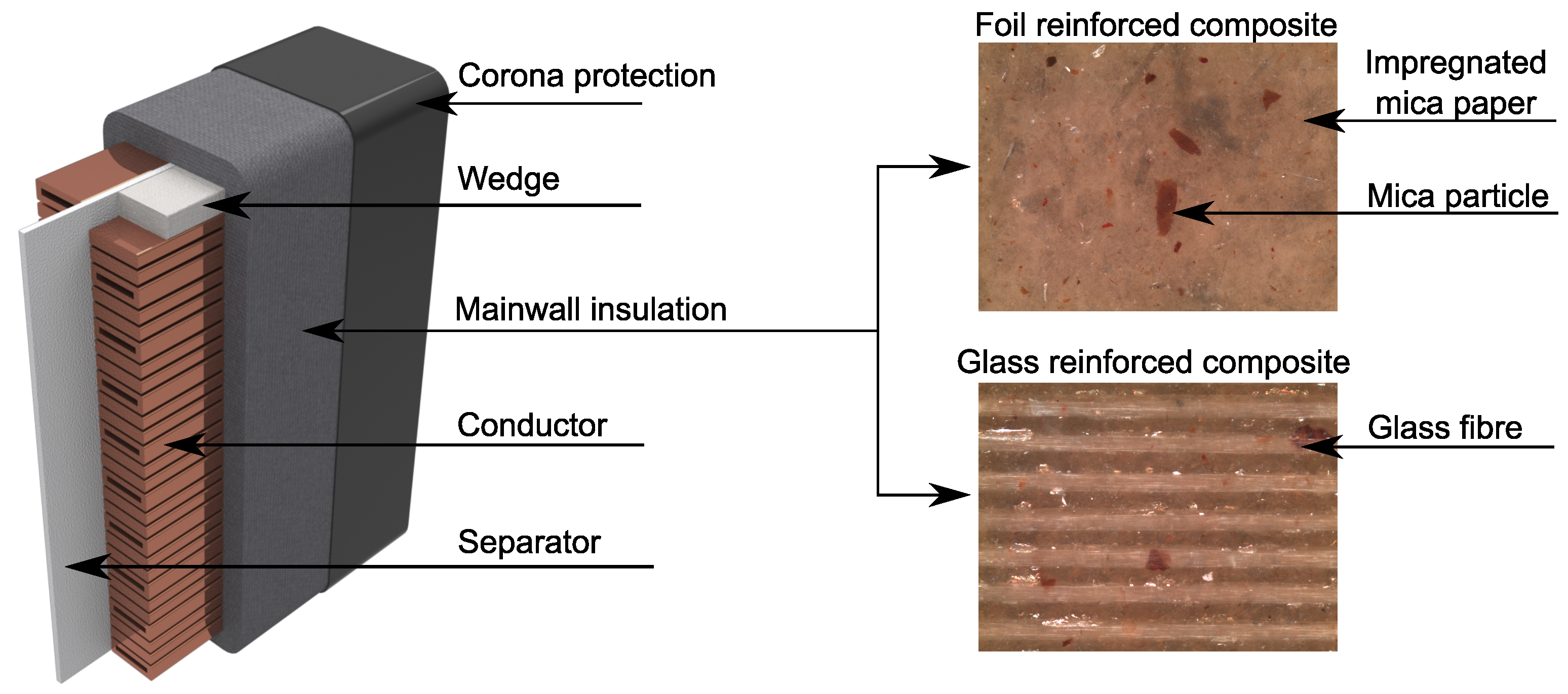
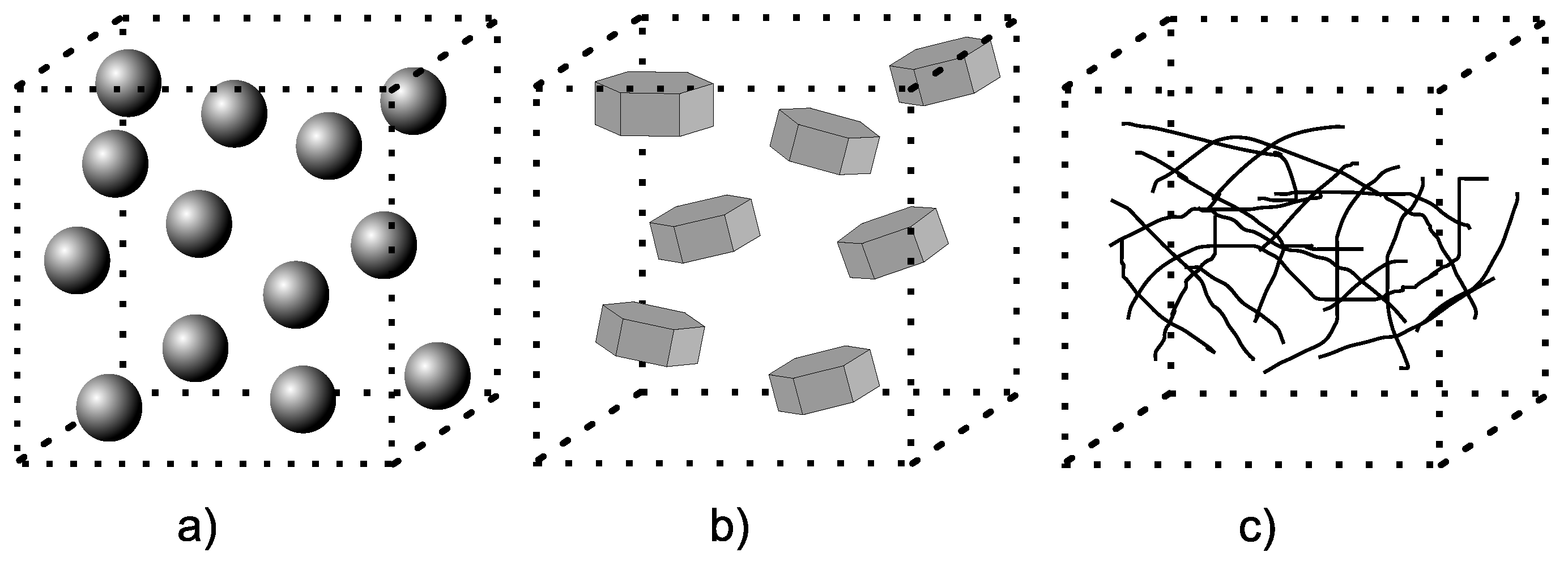


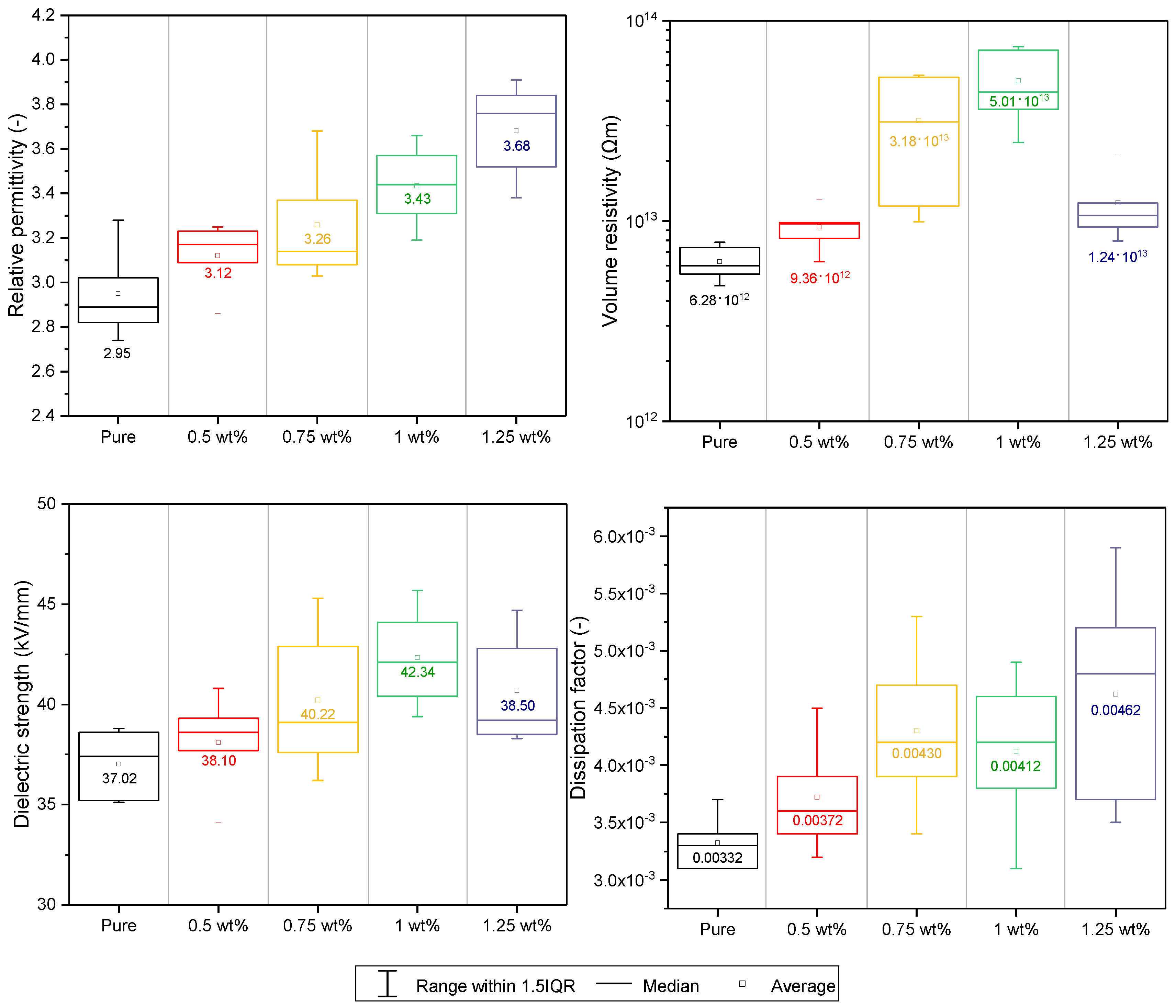
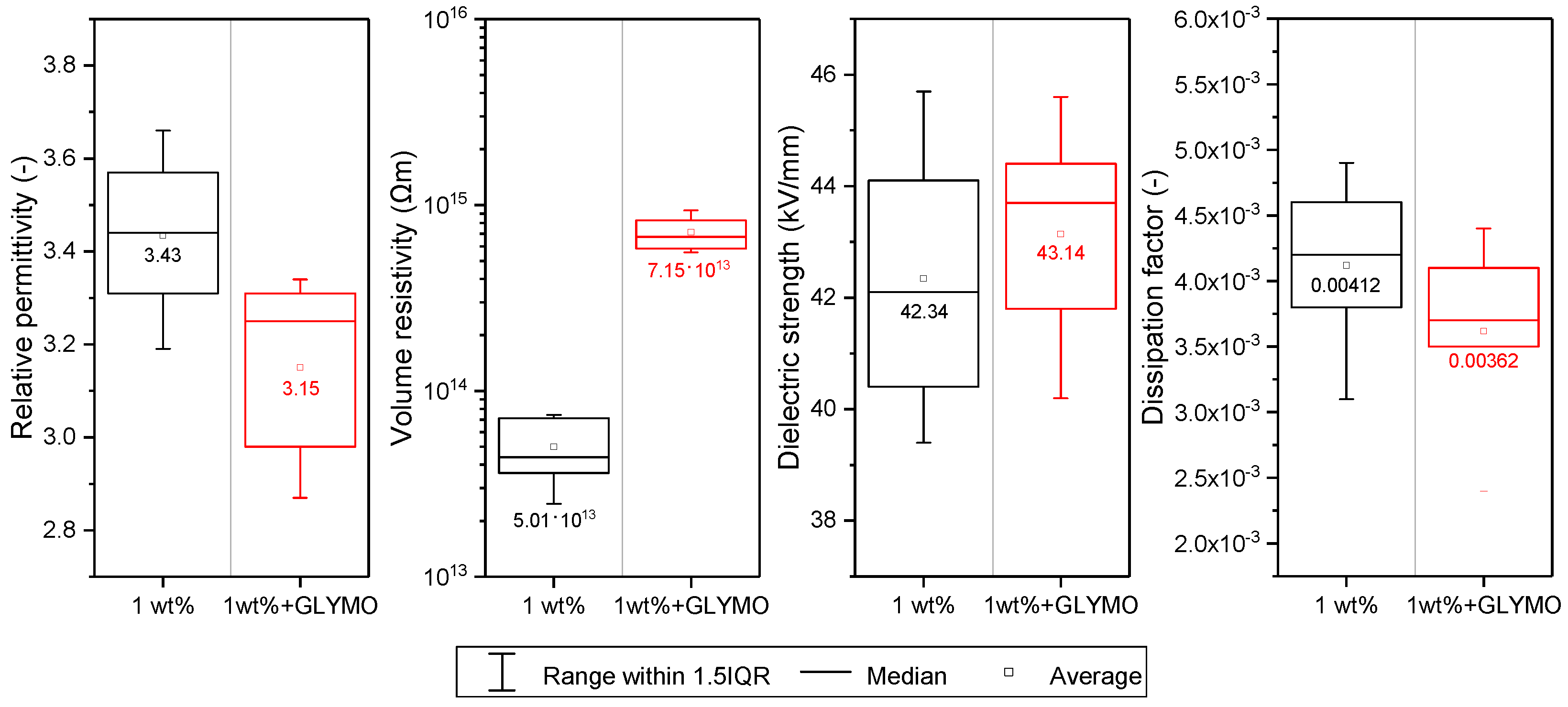
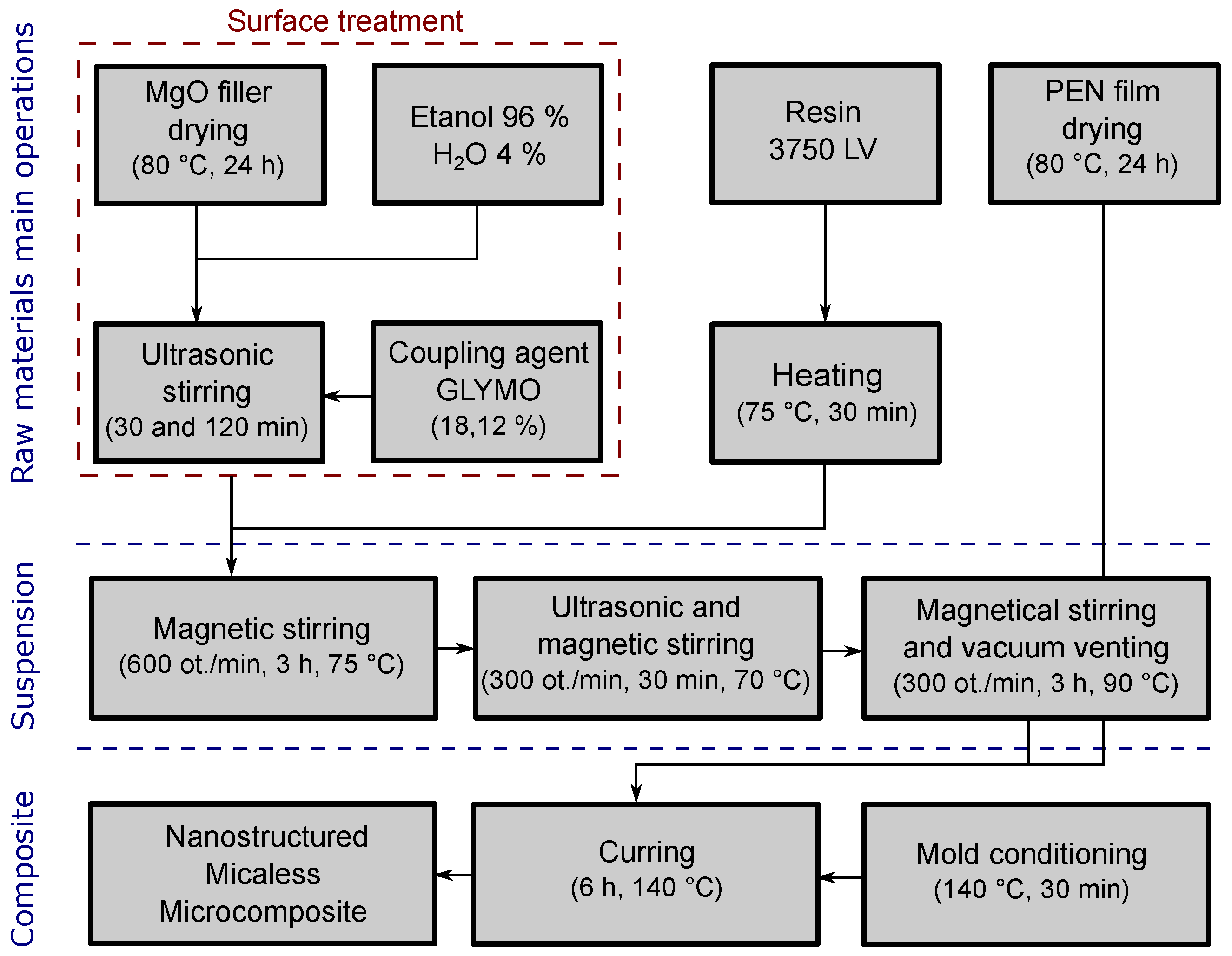
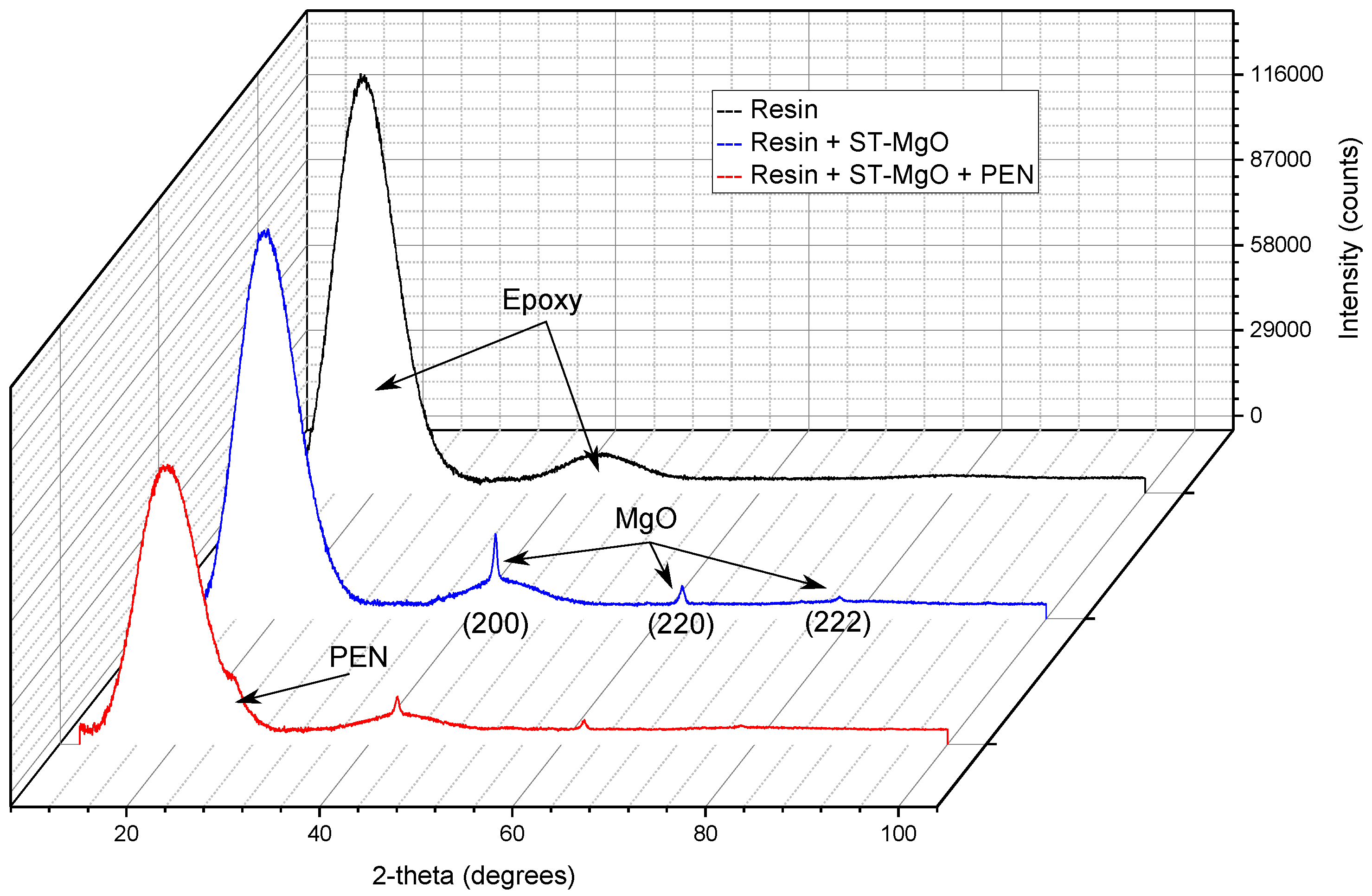


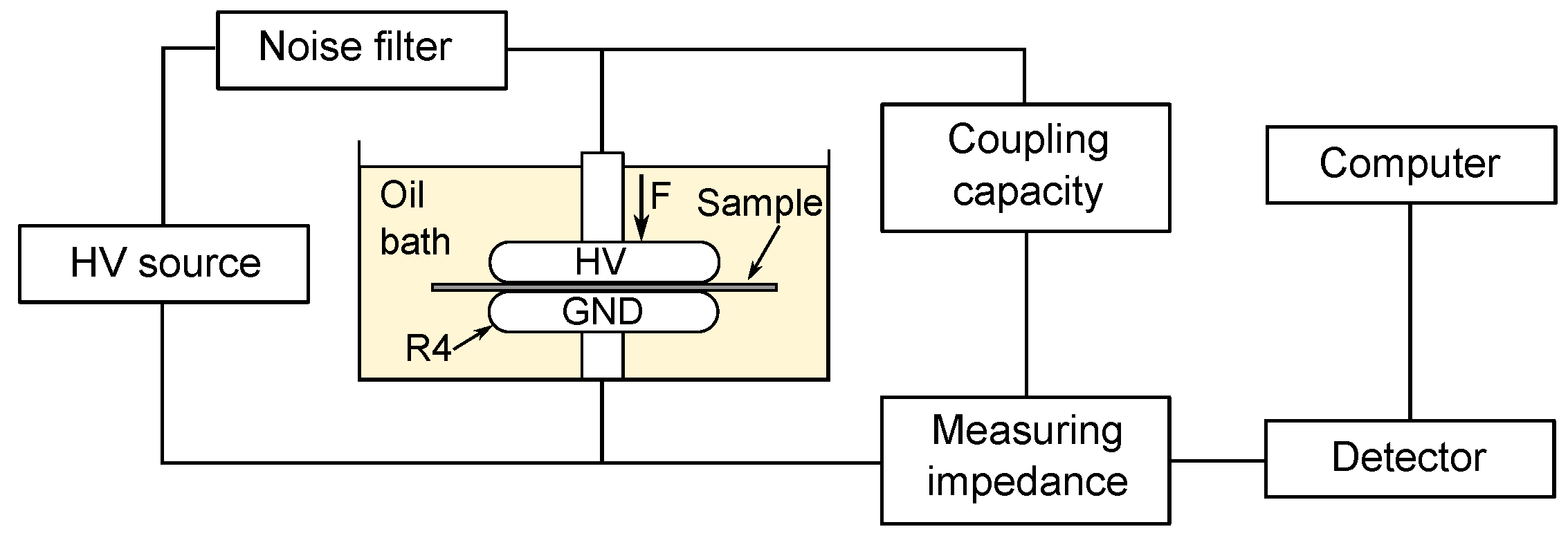

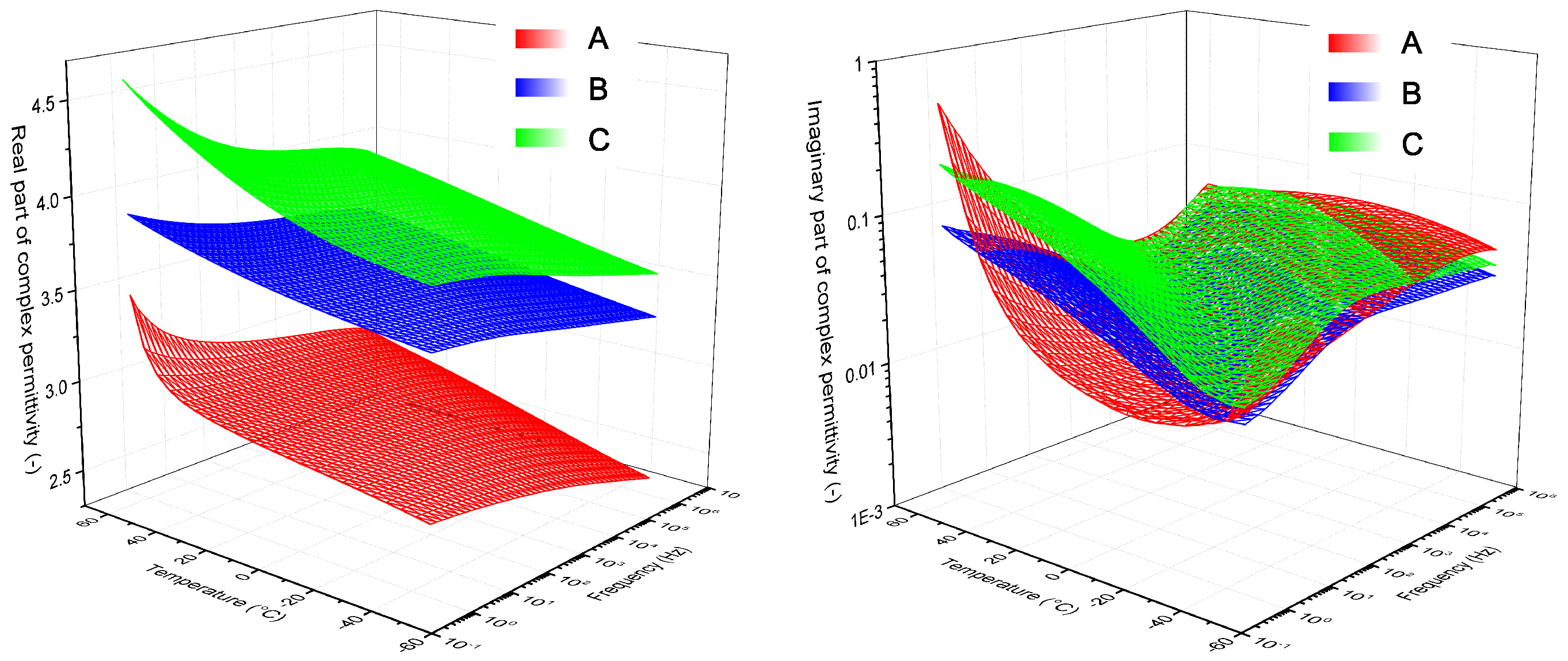
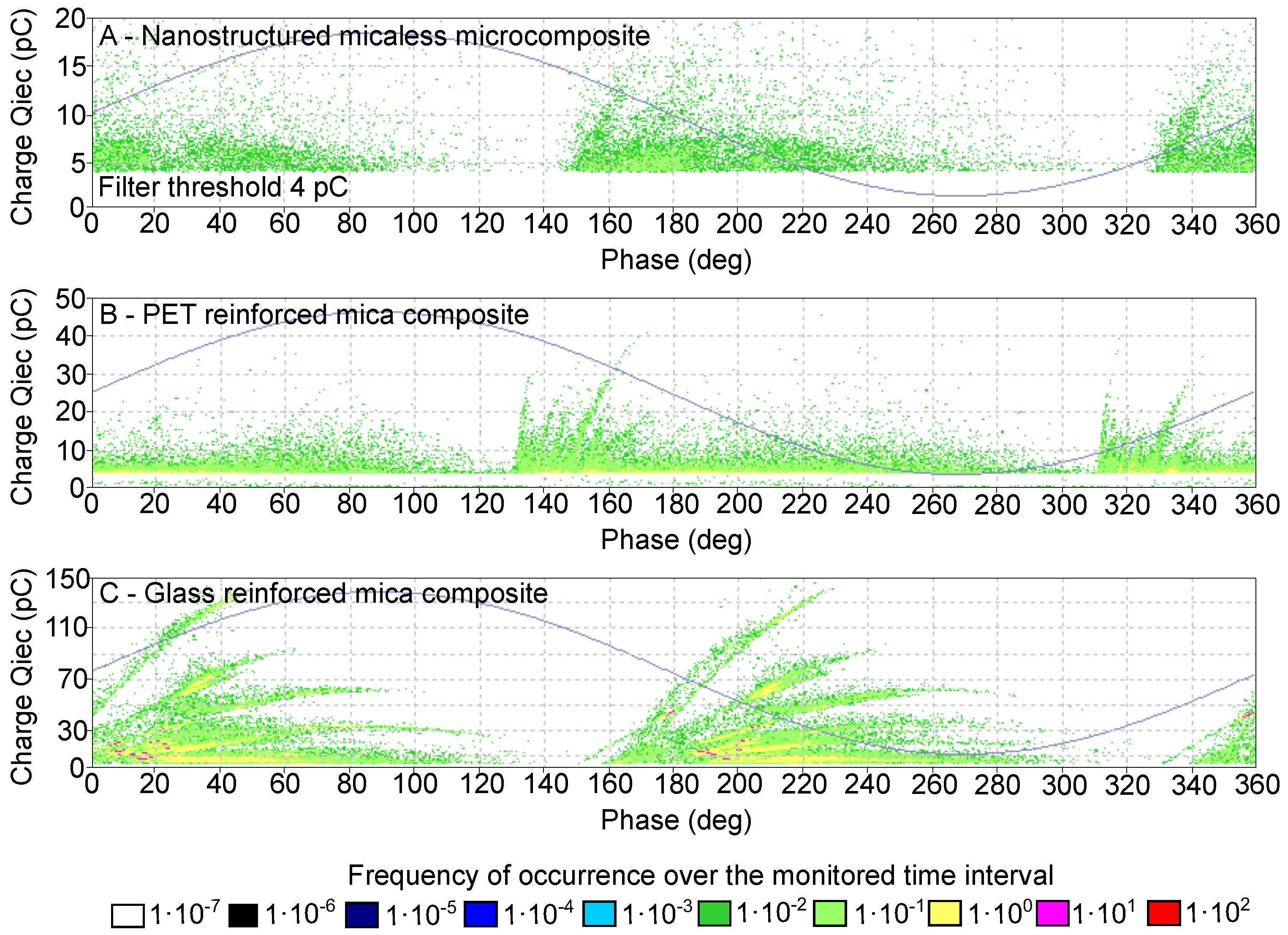
| Parameter | Test Voltage (V) | Frequency (Hz) | Temperature (°C) |
|---|---|---|---|
| Dielectric strength | ↑ 3 kV/s | 50 (AC) | |
| Dissipation factor | 1000 | 50 (AC) | 23 ± 2 |
| Volume resistivity | 1000 | DC |
| Sample | min (kV/mm) | max tan (-) | min (m) |
|---|---|---|---|
| A—Nanostructured micaless microcomposite | 53.2 | 0.00452 | 4.84 × 1014 |
| B—PET reinforced mica composite [28] | 50 | 0.015 | 1 × 1013 |
| C—Glass reinforced mica composite [28] | 35 | 0.015 | 1 × 1013 |
| Sample | Area over Curve (-) | Time Constant (s) |
|---|---|---|
| A—Nanostructured micaless microcomposite | 2.08 × 10−8 | 5.8 |
| B—PET reinforced mica composite | 5.89 × 10−8 | 7.2 |
| C—Glass reinforced mica composite | 9.32 × 10−8 | 8.8 |
| Sample | PD Inception (kV/mm) | Charge Qiec 1 (pC) | Charge Qiec 2 (pC) |
|---|---|---|---|
| A—Nanostructured micaless microcomposite | 18.5 | 10 | 10 |
| B—PET reinforced composite | 16.6 | 20 | 37 |
| C—Glass reinforced composite | 10 | 25 | 117 |
© 2019 by the authors. Licensee MDPI, Basel, Switzerland. This article is an open access article distributed under the terms and conditions of the Creative Commons Attribution (CC BY) license (http://creativecommons.org/licenses/by/4.0/).
Share and Cite
Hornak, J.; Mentlík, V.; Trnka, P.; Šutta, P. Synthesis and Diagnostics of Nanostructured Micaless Microcomposite as a Prospective Insulation Material for Rotating Machines. Appl. Sci. 2019, 9, 2926. https://doi.org/10.3390/app9142926
Hornak J, Mentlík V, Trnka P, Šutta P. Synthesis and Diagnostics of Nanostructured Micaless Microcomposite as a Prospective Insulation Material for Rotating Machines. Applied Sciences. 2019; 9(14):2926. https://doi.org/10.3390/app9142926
Chicago/Turabian StyleHornak, Jaroslav, Václav Mentlík, Pavel Trnka, and Pavol Šutta. 2019. "Synthesis and Diagnostics of Nanostructured Micaless Microcomposite as a Prospective Insulation Material for Rotating Machines" Applied Sciences 9, no. 14: 2926. https://doi.org/10.3390/app9142926
APA StyleHornak, J., Mentlík, V., Trnka, P., & Šutta, P. (2019). Synthesis and Diagnostics of Nanostructured Micaless Microcomposite as a Prospective Insulation Material for Rotating Machines. Applied Sciences, 9(14), 2926. https://doi.org/10.3390/app9142926







